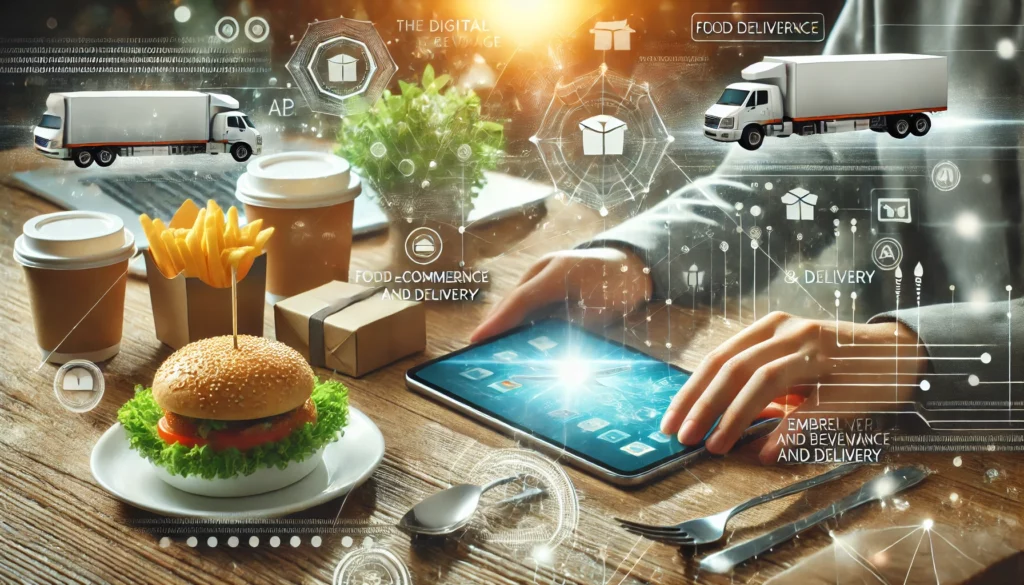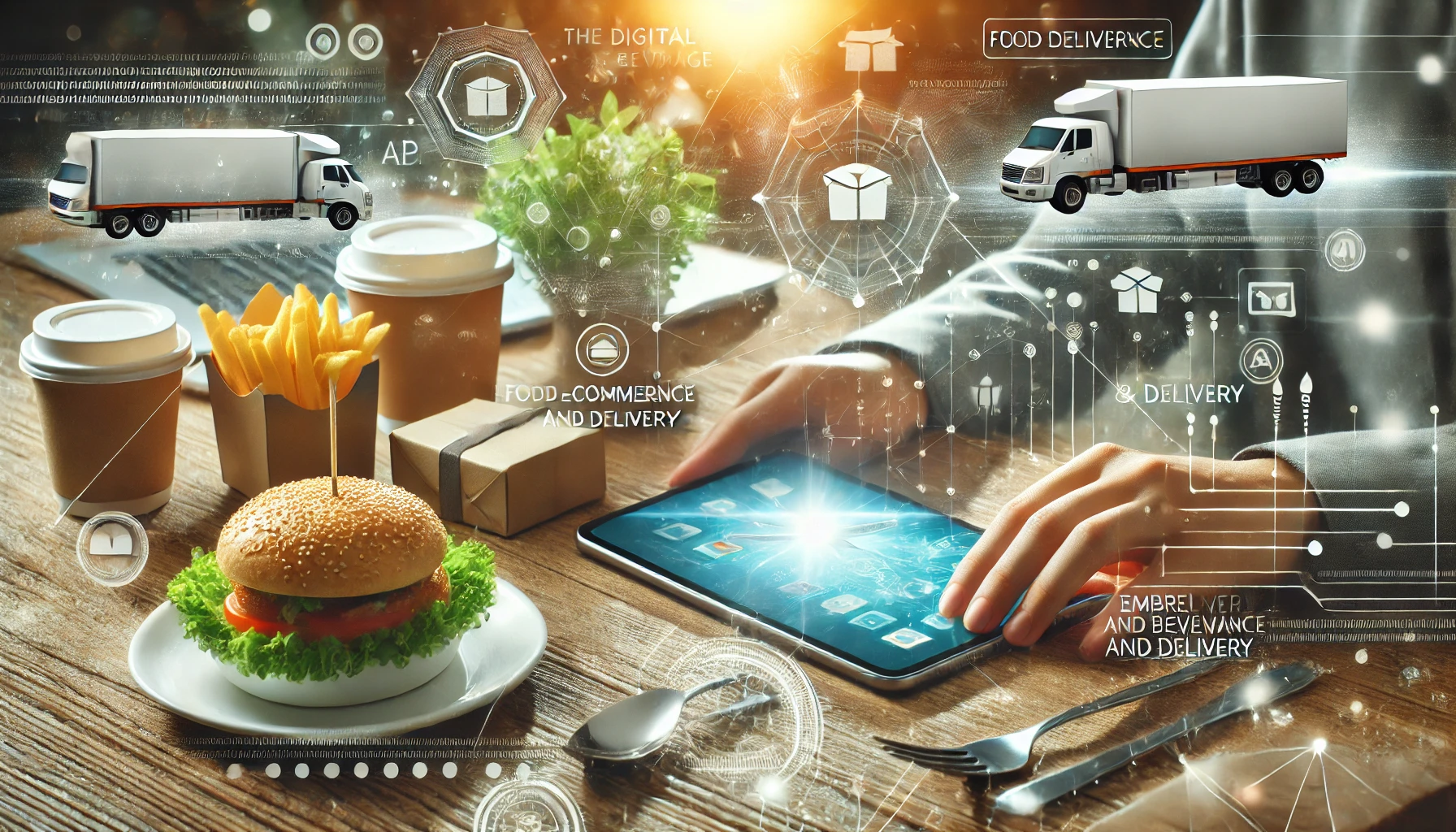
In recent years, the food and beverage sector has undergone a massive transformation, driven by the growth of digital technologies. From restaurant apps to e-commerce platforms and food delivery services, digital innovations are reshaping how consumers interact with food businesses. This article explores how e-commerce and delivery models are revolutionizing the food and beverage industry, offering new opportunities for businesses and enhancing customer experiences.
1. Introduction: The Rise of Digital in the Food and Beverage Sector
The food and beverage industry has always been driven by customer demand, but with the advent of digital technologies, businesses are now forced to keep up with rapidly changing consumer expectations. Digital tools are not just a convenience but a necessity for survival in a competitive market. The rise of e-commerce and food delivery services has had an immense impact on how food is consumed, bought, and sold.
2. E-Commerce: A New Era for Food Sales
2.1 What is E-Commerce in the Food and Beverage Sector?
E-commerce in the food and beverage sector refers to the online buying and selling of food products. This includes anything from ready-to-eat meals to raw ingredients and beverages, all available for purchase via websites and mobile applications. The simplicity of placing an order online has reshaped how people buy food, leading to the widespread adoption of digital platforms.
2.2 The Growth of Online Grocery Shopping
One of the key drivers of digital transformation is the increasing popularity of online grocery shopping. The COVID-19 pandemic accelerated the shift toward online grocery platforms, as people preferred the convenience and safety of shopping from home. Today, many consumers expect a seamless online grocery shopping experience, which has encouraged food brands and retailers to invest heavily in e-commerce platforms.
2.3 Benefits of E-Commerce for Food Businesses
For food businesses, the benefits of e-commerce are undeniable:
- Wider Reach: E-commerce opens up new markets beyond the local area, allowing food brands to reach national and even global audiences.
- Convenience: Customers can shop for their favorite foods anytime, anywhere, making it easier to drive sales.
- Customer Insights: Digital platforms allow businesses to gather valuable data on customer preferences and behaviors, helping to personalize offerings and marketing efforts.
3. The Impact of Delivery Services on the Food Industry
3.1 The Rise of Food Delivery Platforms
Food delivery services, such as UberEats, DoorDash, and Grubhub, have seen explosive growth in recent years. These platforms connect consumers with local restaurants and food vendors, enabling them to place orders and have food delivered directly to their doorstep. The convenience and speed offered by these services have become a vital component of modern dining.
3.2 The Consumer’s Demand for Convenience
Consumers today are busier than ever, and the demand for convenience is at an all-time high. Whether it’s a busy professional or a family looking to enjoy a meal without the hassle of cooking, food delivery services provide an attractive solution. By embracing these platforms, restaurants can cater to the evolving needs of their customer base, providing them with the flexibility they expect.
3.3 The Role of Subscription-Based Delivery Services
Subscription-based food delivery services have also gained traction. These services allow consumers to subscribe to weekly or monthly meal deliveries, often focusing on specific types of food (e.g., healthy meals, plant-based options, or family-sized portions). This model not only guarantees a steady stream of revenue for businesses but also fosters customer loyalty.
4. How Digital Transformation Enhances Customer Experience
4.1 Personalization Through Data and AI
One of the major benefits of embracing e-commerce and delivery services is the ability to collect data on customer preferences. By leveraging artificial intelligence (AI) and machine learning, businesses can personalize the customer experience, offering tailored recommendations based on past purchases and browsing history. This level of personalization can help to increase sales and enhance customer satisfaction.
4.2 Streamlined Ordering and Payment Processes
Digital platforms have simplified the ordering and payment process. Consumers can browse menus, place orders, and pay with a few taps on their smartphones. This frictionless experience not only enhances customer satisfaction but also reduces the chances of abandoned orders, leading to higher conversion rates.
4.3 Enhanced Customer Service Through Chatbots and Virtual Assistants
Chatbots and virtual assistants are being widely adopted to improve customer service in the food and beverage sector. These AI-powered tools can help answer customer inquiries, provide order updates, and even make recommendations based on customer preferences. By implementing these technologies, food businesses can offer round-the-clock support without the need for human intervention.
5. The Role of Social Media in the Digital Transformation of Food and Beverage
5.1 Leveraging Social Media for Marketing
Social media has become an indispensable marketing tool for food and beverage brands. Platforms like Instagram, Facebook, and TikTok allow businesses to showcase their products, engage with customers, and run targeted advertising campaigns. Social media marketing is particularly effective in the food industry, where visuals play a huge role in attracting customers.
5.2 Influencer Partnerships and User-Generated Content
Influencer marketing has proven to be incredibly successful in the food and beverage sector. By partnering with food influencers, restaurants, and brands can tap into established audiences, increasing brand awareness and driving traffic to their e-commerce platforms. Additionally, user-generated content, such as reviews and photos shared by customers, can serve as valuable social proof for new customers.
6. Challenges in Adopting Digital Technologies
6.1 Overcoming Resistance to Change
While digital transformation offers numerous benefits, some businesses are hesitant to embrace new technologies. Older generations of restaurant owners or food producers may be resistant to change due to a lack of familiarity with digital tools. Overcoming this resistance is crucial for businesses to stay competitive in a rapidly evolving market.
6.2 Managing Delivery Logistics and Costs
Food delivery services can be expensive to manage, especially when it comes to logistics. Restaurants and food businesses must account for delivery fees, packaging costs, and the logistical challenges of delivering fresh food on time. These factors can strain small businesses, which may struggle to compete with larger players in the market.
7. The Future of E-Commerce and Delivery in Food and Beverage
7.1 The Role of Artificial Intelligence and Automation
Looking forward, artificial intelligence and automation will continue to play a significant role in shaping the food and beverage industry. From automated kitchens to predictive analytics that forecast food demand, AI will drive efficiency and innovation in the sector. This technological advancement promises to improve operations and streamline supply chains.
7.2 Sustainability and Eco-Friendly Packaging
As consumers become more environmentally conscious, there is a growing demand for sustainable packaging and eco-friendly practices in the food and beverage sector. Businesses that prioritize sustainability in their e-commerce and delivery models will not only appeal to environmentally conscious consumers but also differentiate themselves in a crowded market.
8. Conclusion: Embracing the Digital Future of Food and Beverage
The digital transformation of the food and beverage industry is undeniable. E-commerce and food delivery platforms have reshaped the way businesses interact with customers, providing convenience, personalization, and innovation. As the industry continues to evolve, businesses that embrace these digital tools will remain competitive and thrive in an increasingly digital world.
FAQs
1. How can small food businesses benefit from e-commerce?
Small food businesses can expand their reach and gain access to new customers by offering their products online. E-commerce also allows them to collect valuable customer data and enhance their marketing strategies.
2. What is the role of AI in food delivery services?
AI plays a significant role in food delivery services by predicting customer preferences, optimizing delivery routes, and personalizing the customer experience.
3. Are food delivery services environmentally friendly?
While food delivery services offer convenience, they can contribute to environmental concerns such as packaging waste. However, many companies are now adopting sustainable practices to minimize their environmental impact.
4. How does social media influence food purchasing decisions?
Social media platforms, such as Instagram and TikTok, have a significant influence on food purchasing decisions by showcasing visually appealing food and encouraging user engagement through influencer partnerships.
5. What are the main challenges in adopting digital technologies in the food sector?
Some of the challenges include resistance to change, especially among traditional businesses, and the high costs associated with delivery logistics and digital infrastructure.
Read More :
